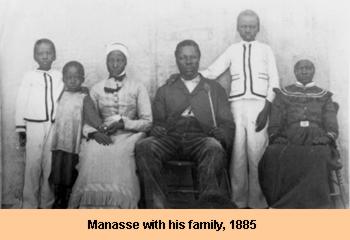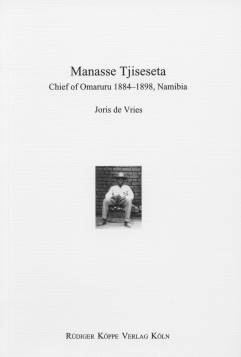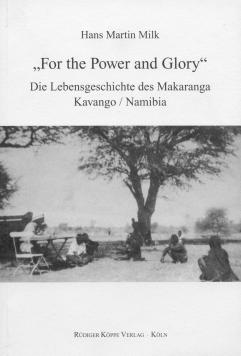


Manasse Tjiseseta, Chief of Omaruru, 1884–1898, Namibia
Author: Joris de Vries. Series edited by: Michael Bollig, Wilhelm J.G. Möhlig †.
Series: HSA History, Cultural Traditions and Innovations in Southern Africa Volume 6
1999146 pp.
2 maps, 10 b/w photos, 14 facsimile reproductions
Text language(s): English
Format: 160 x 240 mm
350 g
Paperback
€ 34.80
Buy 'Manasse Tjiseseta, Chief of Omaruru, 1884–1898, Namibia' as a downloadable PDF document directly from our online shop »
Order 'Manasse Tjiseseta, Chief of Omaruru, 1884–1898, Namibia' as print edition »
This book deals with the biography of Manasse Tjiseseta, chief of Omaruru in central German Southwest Africa (today Namibia) between 1884 and 1898. He played an important but little recognized and scarcely documented role in the turbulent history of the Herero, and his actions had a lasting influence on this history. Manasse’s achievements have to be seen against the background of increasing German colonial influence in Namibia at the end of the 19th century, coupled with the policies of the co-operating Rhenish Missionary Society (RMS). His pragmatic leadership and diplomatic skills led the German colonial government to regard him as the most intelligent and at the same time most dangerous chief in Namibia. In the space of only a few years Manasse’s economic understanding led Omaruru to a considerable degree of prosperity.
Yet he could not hinder that after his death in 1898 Omaruru eventually lost its independence. In his analysis the author uses so far unpublished photo material drawn from the National Archives of Namibia (Windhoek) and the archives of the United Evangelical Mission (UEM, Wuppertal / Germany), and political treaties in German and Afrikaans. English translations of the treaty texts and facsimile examples of the originals are included.
The study is divided chronologically, starting prior to Manasse’s election to the chieftaincy of Omaruru and following the ebb and flow of his 14 years in power under the ever increasing influence of the German colonial establishment. On a more general level the book brings into view the political activities in Namibia against the backdrop of German colonial and missionary activities in Africa on the whole. Its intended readership comprises africanists, cultural anthropologists, ethnohistorians and historians of German colonial and missionary history as well as the broader public interested in the history and culture of Namibia.
Following these links you will find further studies of languages, cultures and the history of Namibia, as well as book editions with (auto)biographical contents:
Accompanying material:
- “Grandmother’s Footsteps”
(ISBN 978-3-89645-056-2 ) - “We Thought we would be Free ...”
(ISBN 978-3-89645-057-9 ) - „For the Power and Glory“
(ISBN 978-3-89645-451-5 ) - „Widerstand und Gottesfurcht“
(ISBN 978-3-89645-059-3 ) - A Dictionary of the Rumanyo Language
(ISBN 978-3-89645-601-4 ) - Frühe Kolonialgeschichte Namibias, 1880–1930
(ISBN 978-3-89645-058-6 ) - Hendrik Witbooi – ein Leben für die Freiheit
(ISBN 978-3-89645-315-0 ) - Herrschaft, Macht und Einfluß
(ISBN 978-3-89645-359-4 ) - People, Cattle and Land
(ISBN 978-3-89645-363-1 ) - Reference Grammar of Herero (Otjiherero)
(ISBN 978-3-89645-602-1 ) - San and the State
(ISBN 978-3-89645-357-0 ) - Singing in the Bush
(ISBN 978-3-89645-355-6 ) - The Kavango Peoples in the Past
(ISBN 978-3-89645-353-2 ) - Trommeln in der Kirche
(ISBN 978-3-89645-917-6 )
Cross-reference:
- Chanter l’existence
(ISBN 978-3-89645-287-0 ) - Der Junge aus Duala
(ISBN 978-3-89645-182-8 ) - Ein Leben im Dienste der Afrikanistik
(ISBN 978-3-89645-631-1 ) - Heimkehr aus Babylon
(ISBN 978-3-89645-913-8 ) - Life and Poems of Bi Zainab Himid (1920–2002) / Maisha na Tungo za Bi Zainab Himid (1920–2002)
(ISBN 978-3-89645-286-3 ) - Muhamadi Kijuma
(ISBN 978-3-89645-174-3 ) - Religion und Heilkunst der Toba-Batak auf Sumatra
(ISBN 978-3-89645-445-4 ) - Shizu – Early Days in Hakata, Japan
(ISBN 978-3-89645-232-0 ) - Sie kamen als Forscher und Ärzte ...
(ISBN 978-3-89645-228-3 ) - Ushaka
(ISBN 978-3-927620-81-0 )
Reviews
Dag Henrichsen in Journal of African History, 42/2001, 511-512
De Vries has a short, interesting story to tell [...]
Axel Harneit-Sievers in International Journal of African Historical Studies, 33/2, 2000, 506
| « back | Print version | [top] |
 Books
Books Audio
Audio Biographies
Biographies Series
Series Festschrifts
Festschrifts Journals
Journals